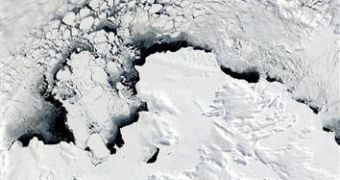Experts have detected that a Texas-sized ice pack of Antarctica is thinning and could make the ocean level rise significantly in the long-term.
"Surprisingly rapid changes are occurring in Antarctica's Amundsen Sea Embayment, an ice drainage system that faces the southern Pacific Ocean," warn the experts, pointing out for more research to assess the rhythm of the melting and how much it could affect the ocean level.
The researchers blamed the melting ice on changes in the winds surrounding Antarctica that are moving warmer waters beneath the ice packs in the Amundsen Sea. The Amundsen shelf represents ice that formed on the continent and is called the West Antarctic Ice Sheet. If the shelves collapse, grounded ice flowing into the sea would melt much more rapidly. "The wind change, they said, appeared to be the result of several factors, including global warming, ozone depletion in the atmosphere and natural variability", the researchers said.
The thinning in the two-miles (3 km) tall West Antarctic Ice Sheet has been spotted mostly from satellites, but it is difficult to get precise data about how much ice has been lost as information is hard to get in the remote region. "The place where the biggest change is occurring is the Amundsen Sea Embayment," said Donald Blankenship of the University of Texas Institute for Geophysics. "One, it's changing, and two, it can have a big impact. The West Antarctic Ice Sheet contains enough grounded ice to raise world sea levels close to 20 ft (6 m)," he said. "Other parts of the continent also were losing ice, but generally not as quickly."
The much bigger East Antarctic Ice Sheet is considered much more stable. The researchers stated that statement "Satellite observations show that both the grounded ice sheet and the floating ice shelves of the Amundsen Sea Embayment have thinned over the last decades."
"Ongoing thinning in the grounded ice sheet is already contributing to sea-level rise. The thinning of the ice has occurred because melting beneath the ice shelves has increased, reducing the friction holding back the grounded ice sheet and causing faster flow."
"All of the ice on Earth contains enough water to raise sea level over 200 feet (60 m), with about 20 feet (6 m) from Greenland and almost all of the rest from Antarctica".
"Although complete loss of the Antarctic Ice Sheet is not expected, even a small change would matter to coastal populations."
The researchers asked for further investigations, pointing out the fact that the U.N. Intergovernmental Panel on Climate Change report from last February, "could not provide a best estimate or an upper limit on the rate of sea-level rise in coming centuries because of a lack of understanding of the flow of the large ice sheets."

 14 DAY TRIAL //
14 DAY TRIAL //